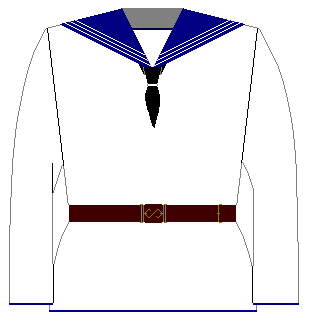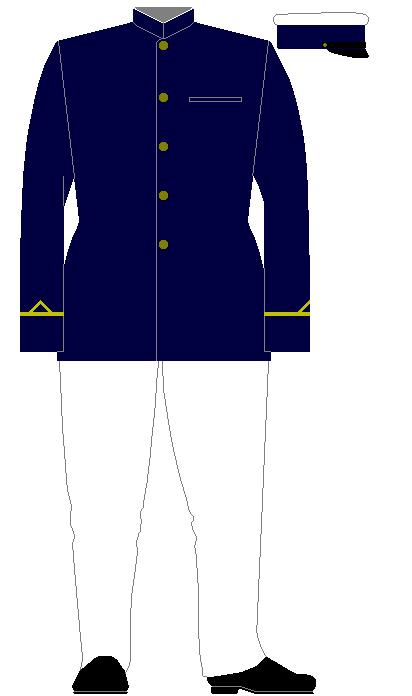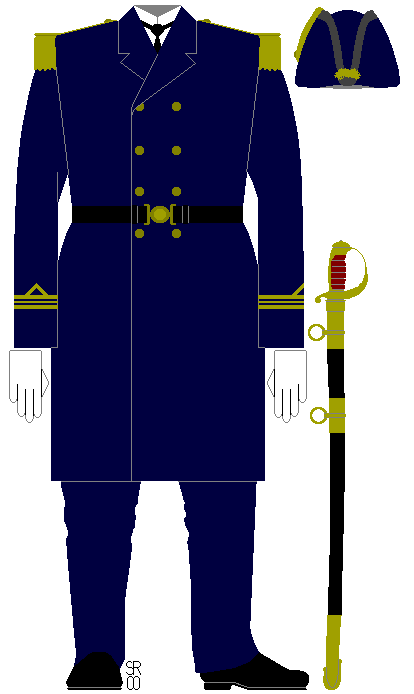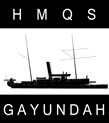(RN uniform details can be found here )
Credit and Thanks for the following plates and information goes to Sean Ryan at Uniforms of the World.
A Rating in summer service dress


The hat is the sennet pattern worn by the Royal Navy. It has a leather binding around the brim’s edge, and a ship’s tally around the base of the crown.
The uniform itself is the same as worn by the RN with no colonial additions. For summer the jacket and trousers are white with blue binding on the sleeve ends and bottom of the jacket. The trousers are quite plain.
At the collar of the jacket is fitted a blue jean collar with three white stripes on the edge. Under this collar is tied a black neckerchief.
For land duties or on parade this Rating carries brown leather equipment consisting of a waist belt and ammunition pouch. The belt supports a cutlass in a leather scabbard.
His rifle is a Martini-Henry Mk.I pattern, in 0.45in calibre.
A Sub-Lieutenant in service dress

The early peaked cap has a soft crown and drooping leather peak. The embroidered Force badge is attached to the front of the band. A white cover is worn over the crown in the hot months or in northern latitudes.
The reefer jacket is more commonly recognised as a naval garment. It follows the RN pattern with rank strips stitched to the cuffs. Beneath the jacket is worn a white shirt with detachable collar. Under the collar is a black necktie.
Plain trousers are worn with ankle boots or shoes.
A Sub-Lieutenant in a mixed version of service dress

This is likely to have been worn in the lower half of the colony’s coastline during the summer months.
The early peaked cap has a soft crown and drooping leather peak. The embroidered Force badge is attached to the front of the band. A white cover is worn over the crown in the hot months or in northern latitudes.
The jacket is quite plain with the only embellishment being the rank lace on the cuffs.
Plain drill trousers are worn with ankle boots or shoes.
A Sub-Lieutenant in mess dress

This uniform was worn for dinners and evening entertainments, and followed the RN pattern.
The jacket is hip length and open at the front. The folded back lapels became a standard pattern for the military in the 20th century. These lapels are black silk. The buttons on the front are ornamental, apart from the top, inner two that are used to close the jacket with a gilt cord. Again rank lace is stitched onto the cuffs.
Under the jacket is worn a starched white shirt with formal detachable collar. A bowtie is worn around the collar base. At the waist is seen a blue cummerbund.
The trousers have a thick black lace stripe down the outer seams, and are worn with shoes.
A Lieutenant in service dress

Used on a daily basis.
The early peaked cap has a soft crown and drooping leather peak. The embroidered Force badge is attached to the front of the band.
The jacket is quite plain with the only embellishments attached to the cuffs. These include gilt lace rank insignia, and buttons and black braid. The top rank ring has a triangular addition, instead of the RN’s loop, a distinctly Queensland touch.
Plain trousers are worn with ankle boots or shoes.
A Lieutenant in summer service dress

Like their land counterparts, naval officers wore sun helmets in the warmer months and latitudes. This had a covering of white drill material, and a multi-fold puggaree of the same cloth. It bore no badges, and rarely a chinstrap.
The jacket is quite plain with the only embellishments being the blue straps attached to the shoulders. These carry the gilt lace rank insignia. The top rank stripe has the Queensland triangular addition.
Plain drill trousers are worn with ankle boots or shoes.
A Lieutenant-Commander in ceremonial dress

The cocked hat is a traditional naval item in blue with black binding. On the right side is a loop of gilt braid secured with a button. At the front and rear are small gilt tassels.
The parade frock coat is long and embellished with rank stripes on the cuffs. Attached to the shoulders are gilt lace and braid epaulettes with a hanging gilt fringe. Beneath the jacket is worn a white shirt with detachable collar. Under the collar is a black necktie.
Around the waist is worn a black leather belt with brass union buckle. The latter bears an anchor badge at its centre. The belt supports the sword shown at right.
White gloves are worn on ceremonial occasions.
Again plain trousers are worn with ankle boots or shoes.
Band Member Dress

The band of the Force wore a simple but unique uniform.
The headdress is a colonial sun helmet with multi-fold blue drill puggaree around the base. No badges appear to be attached, and neither is a chin strap.
The jacket is very simple with hooks and eyes used to close the front, as opposed to the usual buttons. The jacket’s only embellishment is a white collar with blue lace on the edges.
The trousers have a thick white lace stripe down the outer seams, and are worn with shoes.
Cadet

Several naval cadet units were formed in the colony, probably allied to local Naval Brigades.
They wore the same uniform as their older compatriots which included the straw sennet hat shown, this had a black band on which was embroidered the words ‘Naval Volunteer Cadet Corps’ with gilt thread.
This rifleman is armed with a Martini Enfield carbine.
